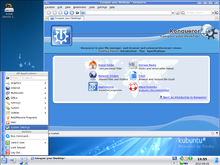KDE 3
 |
|

K Desktop Environment 3.5
|
|
| Developer(s) | KDE |
|---|---|
| Initial release | 3 April 2002 |
| Stable release |
3.5.10 / 26 August 2008
|
| Development status | Superseded by KDE SC 4 |
| Written in | C++ (Qt 3) |
| Operating system | Unix-like with X11 |
| Available in | Multilingual |
| Type | Desktop environment |
| License | GPL and other licenses |
| Website | kde |
 |
|

Trinity 3.5.12
|
|
| Developer(s) | KDE, Pearson Computing |
|---|---|
| Stable release |
14.0.4 / 7 November 2016
|
| Preview release |
14.1.0 Development / 28 February 2016
|
| Development status | Current |
| Written in | C++ (Qt 3) |
| Operating system | Unix-like with X11 |
| Available in | Multilingual |
| Type | Desktop environment |
| License | GPL and other licenses |
| Website | trinitydesktop |
K Desktop Environment 3 is the third series of releases of the K Desktop Environment (after that called KDE Software Compilation). There are six major releases in this series.
K Desktop Environment 3.0 introduced better support for restricted usage, a feature demanded by certain environments such as kiosks, Internet cafes and enterprise deployments, which disallows the user from having full access to all capabilities of a piece of software. To address these needs, KDE 3.0 included a new lockdown framework, essentially a permissions-based system for altering application configuration options that supplements the standard UNIX permissions system. The KDE panel and the desktop manager were modified to employ this system, but other major desktop components, such as Konqueror and the Control Center, had to wait for subsequent releases.
K Desktop Environment 3.0 debuted a new printing framework, KDEPrint. KDEPrint's modular design enabled it to support different printing engines, such as CUPS, LPRng, and . In conjunction with CUPS, KDEPrint was able to manage an elaborate enterprise networked printing system. Since KDEPrint provides a command-line interface, its framework, including its GUI configuration elements, is accessible to non-KDE applications, such as OpenOffice.org, the Mozilla Application Suite, and Acrobat Reader.
This release also introduced a new KDE address book library providing a central address book for all KDE applications. The new library is based on the vCard standard and has provisions for being extended by additional backends such as LDAP and database servers.
K Desktop Environment 3.1 introduced new default window (Keramik) and icon (Crystal) styles as well as several feature enhancements.
The update included greatly improved LDAP integration throughout Kontact, enhanced security for KMail (S/MIME, PGP/MIME and X.509v3 support) and Microsoft Exchange 2000 compatibility for KOrganizer. The desktop lockdown framework, introduced in version 3.0, was extended. Other improvements included tabbed browsing in Konqueror; a new download manager, KGet; a new multimedia player plugin, based on Xine, and a desktop sharing framework.
...
Wikipedia
